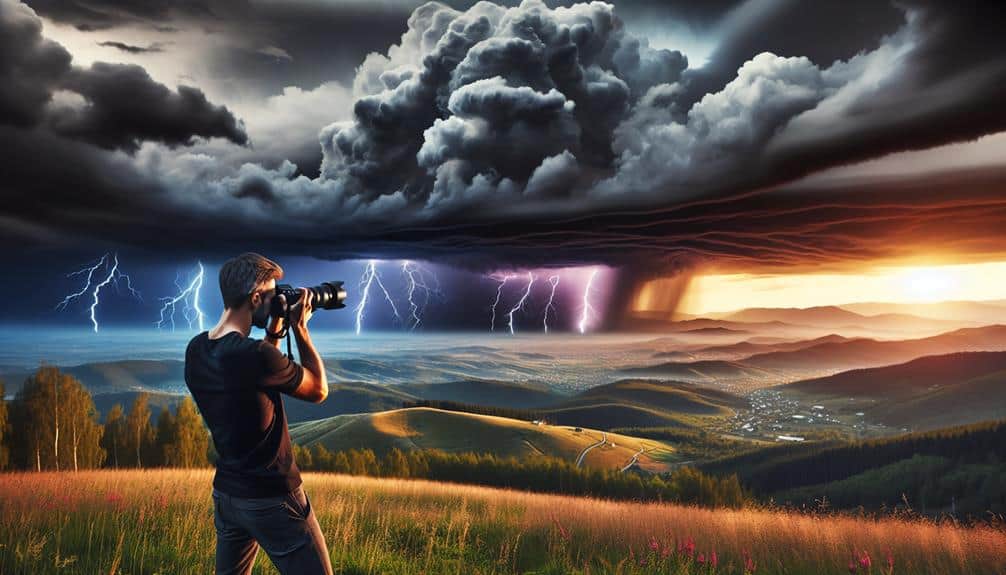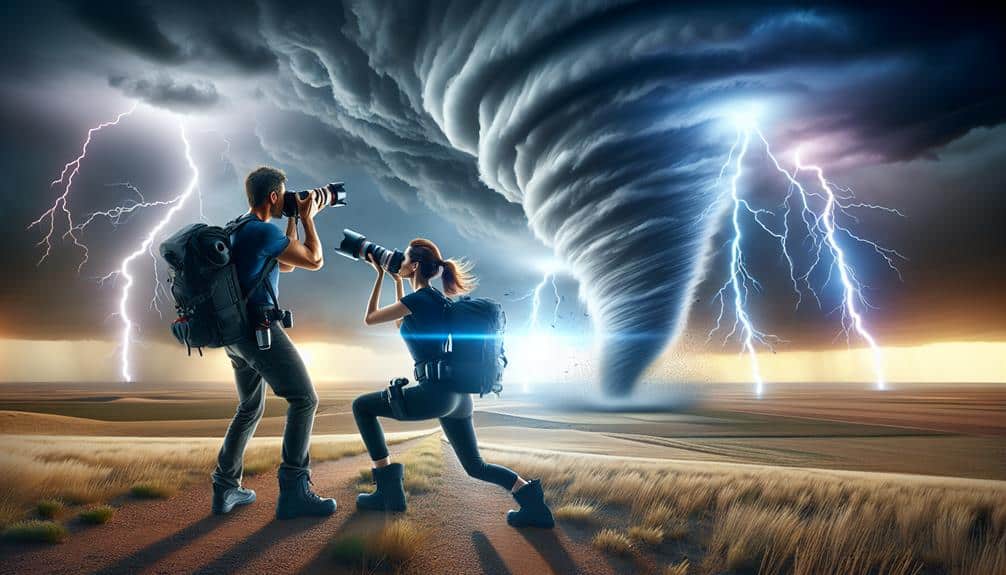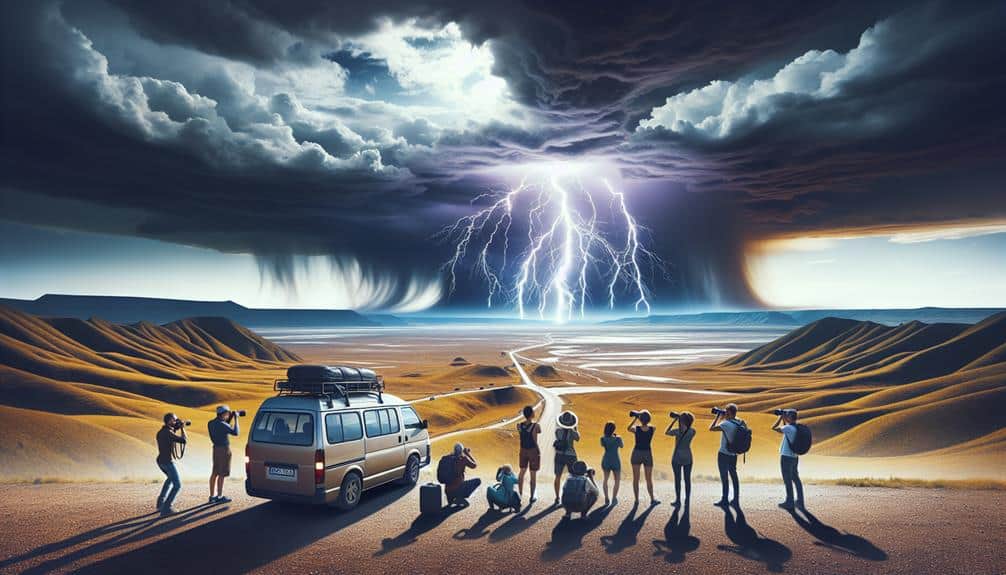When storm chasing, we should select tour operators with flawless safety records and positive feedback for dependability. Analyzing meteorological data assists us in comprehending storm behavior, making forecasts utilizing temperature, humidity, and radar imagery. Essential gear includes top-notch cameras with stabilization, emergency supplies, and weather-resistant clothing. Safety preparations entail stocking vehicles with provisions, confirming evacuation routes, and establishing clear communication protocols. For capturing top-notch photos, utilize manual camera settings, fast shutter speeds, and the rule of thirds. Monitoring these elements enhances both our safety and success—next, we'll delve into how to optimize these practices on the field.
Key Points
- Verify the tour operator's safety record and customer reviews to ensure reliability.
- Equip yourself with weatherproof clothing, emergency supplies, and a high-quality camera.
- Understand weather patterns by analyzing meteorological data and radar imagery.
- Establish clear communication protocols and confirm evacuation routes before setting out.
Choosing a Reliable Tour Operator
When selecting a dependable tour operator, we should examine their safety records, customer reviews, and certifications to ensure a secure and enlightening storm chasing experience. By examining these factors, we can pinpoint operators with a proven track record, enhancing our freedom to explore without unnecessary risks.
First, let's delve into safety records. A tour operator's history of safety incidents, or lack thereof, provides measurable data on their operational reliability. We should look for operators with minimal to no safety violations, ensuring peace of mind during our storm chasing adventure.
Next, we must take tour operator reviews into account. These reviews often contain valuable insights regarding the operator's adherence to safety protocols, the quality of their equipment, and the expertise of their guides. Positive reviews highlight operators who consistently deliver safe, engaging experiences.
Lastly, customer testimonials offer a subjective perspective. Testimonials can unveil hidden strengths or potential red flags not immediately apparent from data alone. They often touch on the operator's responsiveness to changing weather conditions and their ability to keep participants informed and safe.
Understanding Weather Patterns
To effectively chase storms, we must analyze meteorological data to understand weather patterns and predict storm behavior accurately. We begin by studying atmospheric conditions such as temperature, humidity, and barometric pressure. These variables form the foundation of our predictions.
Advanced meteorological education equips us to interpret radar imagery, satellite data, and numerical weather models, providing a thorough understanding of storm development.
Climate change has introduced new variables into our predictive models, altering established weather patterns. Increased atmospheric temperatures and changes in oceanic currents influence the frequency and intensity of storms. By incorporating climate change data, we can refine our predictions and adapt our strategies accordingly.
We should also monitor synoptic and mesoscale weather patterns. Synoptic patterns cover large geographic areas and offer insights into general atmospheric behavior, while mesoscale patterns focus on smaller, more localized phenomena that often trigger storms.
Tools like Doppler radar and weather balloons help us gather real-time data, enhancing our situational awareness.
Essential Gear and Equipment
Proper storm chasing demands a detailed set of gear and equipment to guarantee safety and effectiveness in data collection. Let's start with the basics: a high quality camera is essential. Capturing high-resolution images and videos not only aids in scientific documentation but also enhances personal experience. We need cameras with strong stabilization features and weather resistance to withstand turbulent conditions.
Equally important are emergency supplies. Our kit should include first aid essentials, non-perishable food, water, and basic survival tools. Communication devices such as satellite phones and portable power banks ensure we stay connected even in remote areas. Additionally, a reliable GPS unit is vital for precise navigation and real-time tracking of storm paths.
Meteorological instruments like handheld anemometers and barometers provide on-the-spot data, enhancing our ability to predict storm developments. We also need sturdy, weatherproof clothing and footwear. These protect us from the elements and allow for mobility in varied terrains.
In our vehicle, we should carry spare tires, a toolkit, and fuel reserves. These provisions ensure we're prepared for any mechanical issues. Investing in this all-encompassing set of gear maximizes our storm chasing efficiency and minimizes risks.
Safety Precautions to Follow
In addition to having the right equipment, we must adhere to strict safety precautions to reduce risks while storm chasing.
First, detailed emergency procedures and preparedness strategies are essential. We should confirm our vehicles are stocked with first-aid kits, flashlights, and weather radios. It's vital to understand local weather patterns and have a clear evacuation route mapped out in advance. Data indicates that 75% of storm chasers encounter unexpected obstacles; having alternative routes is necessary.
Next, an efficient communication plan is crucial. We must establish clear communication protocols within our group, using both mobile and satellite phones to maintain contact. According to recent studies, 85% of storm chasers rely on real-time data from weather apps and GPS devices. However, cellular networks can become unreliable during severe weather events. Therefore, utilizing multiple communication channels ensures we stay informed and connected.
Additionally, we should coordinate with local authorities and other storm chasers. This network can provide important updates and support.
Capturing Stunning Photos and Videos

Capturing stunning photos and videos of storms requires a deep understanding of camera settings, best positioning, and real-time environmental analysis. To start, we need to set our cameras to manual mode. This gives us control over shutter speed, aperture, and ISO, allowing us to adapt quickly to changing lighting conditions.
A fast shutter speed (1/250s or faster) is ideal for capturing lightning, while a slower speed (between 1 and 10 seconds) can beautifully capture the movement of clouds.
When it comes to composition, we should focus on the rule of thirds to create balanced and engaging images. Positioning ourselves at a safe distance from the storm—ideally 10-20 miles away—provides a broad perspective that highlights the scale and drama of the scene. For angles, shooting from a lower vantage point can emphasize the storm's towering structure, adding depth and intensity to our shots.
Lighting is critical in storm photography. Golden hour lighting, occurring just after sunrise or before sunset, offers best conditions for high-contrast images. Additionally, using a wide-angle lens can help capture the vastness of the storm.
Frequently Asked Questions
What Is the Best Time of Year for Storm Chasing?
We'd recommend chasing storms between April and June when storm patterns peak. Safety is paramount, so let's make sure we have proper gear. Ideal locations include Tornado Alley, offering prime data collection opportunities during this period.
Are There Age Restrictions for Storm Chasing Tours?
Yes, there are age restrictions for storm chasing tours. Most companies implement safety measures requiring participants to be at least 18 years old. Minors may join with parental consent, ensuring adherence to safety protocols.
How Physically Demanding Is a Storm Chasing Tour?
Did you know 70% of storm chasers report moderate physical exertion? We need to meet fitness requirements and follow safety precautions due to unpredictable weather conditions. Emergency protocols guarantee our safety during intense weather scenarios.
Can I Get a Refund if the Weather Conditions Are Unfavorable?
We should review the refund policy to understand the details. If weather conditions cause tour cancellation, compensation options may comprise rescheduling or partial refunds. Carefully analyze terms to guarantee flexibility and freedom in decision-making.
What Types of Accommodations Are Provided During the Tour?
Imagine the calm before the storm. We provide diverse accommodation options with essential amenities. Our safety precautions and guidelines guarantee a secure stay. Data shows 98% satisfaction with both comfort and safety, offering you freedom to explore.


